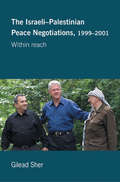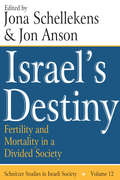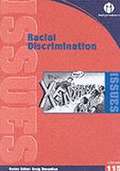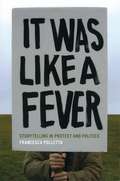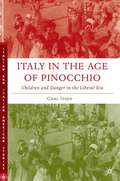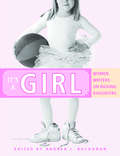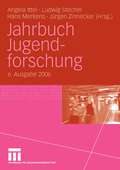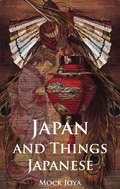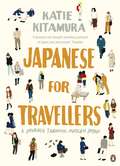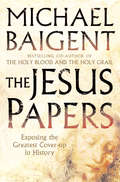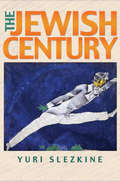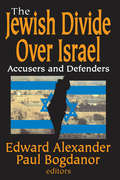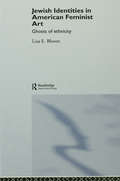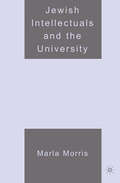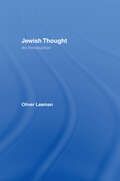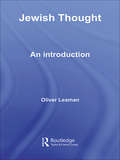- Table View
- List View
Israeli-Palestinian Peace Negotiations, 1999-2001: Within Reach (Israeli History, Politics and Society)
by Gilead SherWritten by Gilead Sher, Israeli Chief of Staff during the tumultuous 1999-2000 peace negotiations, this book provides a fast paced description and analysis of the Israeli-Palestinian conflict. Presenting an overview of the core issues of contention, the various key ‘players’ and the possible solutions formulated during the peace process effort, the book sheds new light on the events of that period. An important contribution to the current literature, it provides a fresh understanding of the link between the Israeli-Palestinian conflict and the current global threats of Islamic fanaticism and international terrorism.
Israel's Destiny: Fertility and Mortality in a Divided Society
by Jon AnsonFor over a hundred years, demography has been at the heart of the Zionist project, reflected in the goal of creating and maintaining a Jewish majority in Israel and in ensuring the physical continuation of the Jewish people. Demography continues to be an essential issue in the current struggle between Israel and Palestine. Yet in academic discourse, demography is treated as a minor, largely technical side-issue in the social sciences, with little theoretical consideration given to population processes as social processes. Israel's Destiny: Fertility and Mortality in a Divided Society brings together important recent work in this area. The contributions to Israel's Destiny focus on the influence of religion, religiosity, nationalism, and ethnicity on fertility and mortality in Israel.Israel's Destiny is divided into four sections: the first focuses on fertility, particularly Israel's apparently high birth rate when compared with other countries with a similar standard of living; the second looks at patterns of nuptiality and contraception and the way marriage patterns are shaping group boundaries; the third looks at mortality, particularly among men; and the fourth looks at social policy effects of the demographic process.The main focus is that differential reproduction of the population by national and ethnic group, as well as social class--through fertility and mortality--and the social structuring of the population--through marriage patterns--are critical elements in the creation and evolution of Israeli society. The editors' introduction places all these studies in a wider perspective of current demographic research. The volume provides a concise population history of the state of Israel to help the reader put the studies in their proper local and historical context.
Israel's Destiny: Fertility and Mortality in a Divided Society
by AuthorFor over a hundred years, demography has been at the heart of the Zionist project, reflected in the goal of creating and maintaining a Jewish majority in Israel and in ensuring the physical continuation of the Jewish people. Demography continues to be an essential issue in the current struggle between Israel and Palestine. Yet in academic discourse, demography is treated as a minor, largely technical side-issue in the social sciences, with little theoretical consideration given to population processes as social processes. Israel's Destiny: Fertility and Mortality in a Divided Society brings together important recent work in this area. The contributions to Israel's Destiny focus on the influence of religion, religiosity, nationalism, and ethnicity on fertility and mortality in Israel.Israel's Destiny is divided into four sections: the first focuses on fertility, particularly Israel's apparently high birth rate when compared with other countries with a similar standard of living; the second looks at patterns of nuptiality and contraception and the way marriage patterns are shaping group boundaries; the third looks at mortality, particularly among men; and the fourth looks at social policy effects of the demographic process.The main focus is that differential reproduction of the population by national and ethnic group, as well as social class--through fertility and mortality--and the social structuring of the population--through marriage patterns--are critical elements in the creation and evolution of Israeli society. The editors' introduction places all these studies in a wider perspective of current demographic research. The volume provides a concise population history of the state of Israel to help the reader put the studies in their proper local and historical context.
Issues Series vol. 115: Racial Discrimination (PDF)
by Craig DonnellanRacial Discrimination is the one hundred and fifteenth volume in the Issues series. The aim of this series is to offer up-to-date information about important issues in our world. Racial Discrimination looks at general issues relating to race and racism, as well as the relationship between race, religion and national identity. It is hoped that, as you read about the many aspects of the issues explored in this book, you will critically evaluate the information presented. It is important that you decide whether you are being presented with facts or opinions. Does the writer give a biased or an unbiased report? If an opinion is being expressed, do you agree with the writer? Racial Discrimination offers a useful starting-point for those who need convenient access to information about the many issues involved. However, it is only a starting-point. At the back of the book is a list of organisations which you may want to contact for further information.
Issues Series vol. 115: Racial Discrimination
by Craig DonnellanRacial Discrimination is the one hundred and fifteenth volume in the Issues series. The aim of this series is to offer up-to-date information about important issues in our world. Racial Discrimination looks at general issues relating to race and racism, as well as the relationship between race, religion and national identity. It is hoped that, as you read about the many aspects of the issues explored in this book, you will critically evaluate the information presented. It is important that you decide whether you are being presented with facts or opinions. Does the writer give a biased or an unbiased report? If an opinion is being expressed, do you agree with the writer? Racial Discrimination offers a useful starting-point for those who need convenient access to information about the many issues involved. However, it is only a starting-point. At the back of the book is a list of organisations which you may want to contact for further information.
It Was Like a Fever: Storytelling in Protest and Politics
by Francesca PollettaActivists and politicians have long recognized the power of a good story to move people to action. In early 1960 four black college students sat down at a whites-only lunch counter in Greensboro, North Carolina, and refused to leave. Within a month sit-ins spread to thirty cities in seven states. Student participants told stories of impulsive, spontaneous action—this despite all the planning that had gone into the sit-ins. “It was like a fever,” they said. Francesca Polletta’s It Was Like a Fever sets out to account for the power of storytelling in mobilizing political and social movements. Drawing on cases ranging from sixteenth-century tax revolts to contemporary debates about the future of the World Trade Center site, Polletta argues that stories are politically effective not when they have clear moral messages, but when they have complex, often ambiguous ones. The openness of stories to interpretation has allowed disadvantaged groups, in particular, to gain a hearing for new needs and to forge surprising political alliances. But popular beliefs in America about storytelling as a genre have also hurt those challenging the status quo. A rich analysis of storytelling in courtrooms, newsrooms, public forums, and the United States Congress, It Was Like a Fever offers provocative new insights into the dynamics of culture and contention.
It Was Like a Fever: Storytelling in Protest and Politics
by Francesca PollettaActivists and politicians have long recognized the power of a good story to move people to action. In early 1960 four black college students sat down at a whites-only lunch counter in Greensboro, North Carolina, and refused to leave. Within a month sit-ins spread to thirty cities in seven states. Student participants told stories of impulsive, spontaneous action—this despite all the planning that had gone into the sit-ins. “It was like a fever,” they said. Francesca Polletta’s It Was Like a Fever sets out to account for the power of storytelling in mobilizing political and social movements. Drawing on cases ranging from sixteenth-century tax revolts to contemporary debates about the future of the World Trade Center site, Polletta argues that stories are politically effective not when they have clear moral messages, but when they have complex, often ambiguous ones. The openness of stories to interpretation has allowed disadvantaged groups, in particular, to gain a hearing for new needs and to forge surprising political alliances. But popular beliefs in America about storytelling as a genre have also hurt those challenging the status quo. A rich analysis of storytelling in courtrooms, newsrooms, public forums, and the United States Congress, It Was Like a Fever offers provocative new insights into the dynamics of culture and contention.
It Was Like a Fever: Storytelling in Protest and Politics
by Francesca PollettaActivists and politicians have long recognized the power of a good story to move people to action. In early 1960 four black college students sat down at a whites-only lunch counter in Greensboro, North Carolina, and refused to leave. Within a month sit-ins spread to thirty cities in seven states. Student participants told stories of impulsive, spontaneous action—this despite all the planning that had gone into the sit-ins. “It was like a fever,” they said. Francesca Polletta’s It Was Like a Fever sets out to account for the power of storytelling in mobilizing political and social movements. Drawing on cases ranging from sixteenth-century tax revolts to contemporary debates about the future of the World Trade Center site, Polletta argues that stories are politically effective not when they have clear moral messages, but when they have complex, often ambiguous ones. The openness of stories to interpretation has allowed disadvantaged groups, in particular, to gain a hearing for new needs and to forge surprising political alliances. But popular beliefs in America about storytelling as a genre have also hurt those challenging the status quo. A rich analysis of storytelling in courtrooms, newsrooms, public forums, and the United States Congress, It Was Like a Fever offers provocative new insights into the dynamics of culture and contention.
Italy in the Age of Pinocchio: Children and Danger in the Liberal Era (Italian and Italian American Studies)
by C. IpsenDetailing the development of a new Western attitude to children and their place in society, this book tells the story of Italy's forgotten children at the end of the nineteenth century - foundlings, street children, factory and mine workers, emigrants and delinquents - and illustrates the efforts of the recently unified Italian state to help them.
It's a Girl: Women Writers on Raising Daughters
by Andrea BuchananThe most popular question any pregnant woman is asked - aside from "When are you due?" - has got to be "Are you having a girl or a boy?" When author Andrea Buchanan was pregnant with her daughter, she was thrilled to be expecting a girl. Some people were happy for her; visions of flouncy pink dresses and promises of mother-daughter bonding were the predictable responses. Other people, though, were concerned: "Is your husband OK with that?" "You can try again." "Girls are tough." This mixed message led her to explore the issue herself, with help from her fellow writers and moms, many of whom had had the same experience. As she did in It's a Boy: Women Writers on Raising Sons, Buchanan and her contributors take on what it's really like to raise a child-in this case, a girl-from babyhood to adulthood.It's a Girl, is a wide-ranging, often humorous, and honest collection of essays about the experience of the mother-daughter bond, taking on topics like "princess power" ("Shining, Shimmering, Splendid"), adding a girl to a brood of boys ("Confessions of a Tomboy Mom"), dealing with a daughter's eating disorder ("The Food Rules"), and mothering "hardcore mini-feminists" ("Tough Girls").
Jahrbuch Jugendforschung: 6. Ausgabe 2006
by Angela Ittel Ludwig Stecher Hans Merkens Jürgen ZinneckerDies ist die 6. Ausgabe des Jahrbuchs Jugendforschung. Die Jugendforschung ist nach einer Phase, in der lange die Theoriebildung im Mittelpunkt stand, in der Lage, zunehmend auch angewandte Themen zu diskutieren. Durch die Auswahl mehrerer Schwerpunktthemen wie etwa Bildungsübergänge, Peers und Netzwerkforschung setzt diese Ausgabe Akzente in der Diskussion, die die Jugendforschung in Deutschland, aber auch in Kanada, Israel, Italien und USA derzeit führt.
Japan And Things Japanese
by Mock JoyaFirst published in 2006. For over fifty years, the Japanese-born Western-trained author of this remarkable volume devoted himself to explaining Japanese traditions and customs to foreigners through his newspaper columns, talks and four short books. The comprehensive work presented here, drawn from all these sources deals with all aspects of Japanese life and material culture - apparel and utensils; cures and medicines; houses and buildings; fetes and festivals; fish, birds and animals; folk tales; food, sake and tobacco; living habits; marriage, funerals and memorials; natural phenomena; plants and flowers; popular beliefs and traditions; recreation and entertainment; religious rites and social customs. With over seven hundred and thirty separate entries, this unique volume is the definitive work on all Japanese things.
Japan And Things Japanese
by Mock JoyaFirst published in 2006. For over fifty years, the Japanese-born Western-trained author of this remarkable volume devoted himself to explaining Japanese traditions and customs to foreigners through his newspaper columns, talks and four short books. The comprehensive work presented here, drawn from all these sources deals with all aspects of Japanese life and material culture - apparel and utensils; cures and medicines; houses and buildings; fetes and festivals; fish, birds and animals; folk tales; food, sake and tobacco; living habits; marriage, funerals and memorials; natural phenomena; plants and flowers; popular beliefs and traditions; recreation and entertainment; religious rites and social customs. With over seven hundred and thirty separate entries, this unique volume is the definitive work on all Japanese things.
Japanese for Travellers: A Journey Through Modern Japan
by Katie KitamuraCan you be a stranger in your own country? A Japanese-American raised in California, 24-year-old Katie Kitamura returns to Japan to discover the country she left behind. Travelling across this foreign landscape, she visits middle-class gambling halls, fight stadiums and giant shopping meccas, luxury care homes and cramped apartments housing four generations under a single roof. And she wonders in which version of modern Japan she might have belonged. Defined by its adventurous youth culture, but with the fastest-ageing population in the world, renowned for its strict social code, but producing the black-comedy violence of the Battle Royale films, the Japan she discovers is an often contradictory land of Godzilla toys and war memorials, of futuristic manga characters and brightly coloured vending machines.
The Jesus Papers: Exposing The Greatest Cover-up In History (Plus Ser.)
by Michael BaigentWhat if everything you think you know about Jesus is wrong? In the sequel to ‘The Holy Blood and the Holy Grail’ Michael Baigent reveals the truth and tackles controversial questions, such as whether or not Christ survived the crucifixion.
The Jewish Century
by Yuri SlezkineThis masterwork of interpretative history begins with a bold declaration: The Modern Age is the Jewish Age--and we are all, to varying degrees, Jews. The assertion is, of course, metaphorical. But it underscores Yuri Slezkine's provocative thesis. Not only have Jews adapted better than many other groups to living in the modern world, they have become the premiere symbol and standard of modern life everywhere. Slezkine argues that the Jews were, in effect, among the world's first free agents. They traditionally belonged to a social and anthropological category known as "service nomads," an outsider group specializing in the delivery of goods and services. Their role, Slezkine argues, was part of a broader division of human labor between what he calls Mercurians-entrepreneurial minorities--and Apollonians--food-producing majorities. Since the dawning of the Modern Age, Mercurians have taken center stage. In fact, Slezkine argues, modernity is all about Apollonians becoming Mercurians--urban, mobile, literate, articulate, intellectually intricate, physically fastidious, and occupationally flexible. Since no group has been more adept at Mercurianism than the Jews, he contends, these exemplary ancients are now model moderns. The book concentrates on the drama of the Russian Jews, including émigrés and their offspring in America, Palestine, and the Soviet Union. But Slezkine has as much to say about the many faces of modernity--nationalism, socialism, capitalism, and liberalism--as he does about Jewry. Marxism and Freudianism, for example, sprang largely from the Jewish predicament, Slezkine notes, and both Soviet Bolshevism and American liberalism were affected in fundamental ways by the Jewish exodus from the Pale of Settlement. Rich in its insight, sweeping in its chronology, and fearless in its analysis, this sure-to-be-controversial work is an important contribution not only to Jewish and Russian history but to the history of Europe and America as well.
The Jewish Century
by Yuri SlezkineThis masterwork of interpretative history begins with a bold declaration: The Modern Age is the Jewish Age--and we are all, to varying degrees, Jews. The assertion is, of course, metaphorical. But it underscores Yuri Slezkine's provocative thesis. Not only have Jews adapted better than many other groups to living in the modern world, they have become the premiere symbol and standard of modern life everywhere. Slezkine argues that the Jews were, in effect, among the world's first free agents. They traditionally belonged to a social and anthropological category known as "service nomads," an outsider group specializing in the delivery of goods and services. Their role, Slezkine argues, was part of a broader division of human labor between what he calls Mercurians-entrepreneurial minorities--and Apollonians--food-producing majorities. Since the dawning of the Modern Age, Mercurians have taken center stage. In fact, Slezkine argues, modernity is all about Apollonians becoming Mercurians--urban, mobile, literate, articulate, intellectually intricate, physically fastidious, and occupationally flexible. Since no group has been more adept at Mercurianism than the Jews, he contends, these exemplary ancients are now model moderns. The book concentrates on the drama of the Russian Jews, including émigrés and their offspring in America, Palestine, and the Soviet Union. But Slezkine has as much to say about the many faces of modernity--nationalism, socialism, capitalism, and liberalism--as he does about Jewry. Marxism and Freudianism, for example, sprang largely from the Jewish predicament, Slezkine notes, and both Soviet Bolshevism and American liberalism were affected in fundamental ways by the Jewish exodus from the Pale of Settlement. Rich in its insight, sweeping in its chronology, and fearless in its analysis, this sure-to-be-controversial work is an important contribution not only to Jewish and Russian history but to the history of Europe and America as well.
The Jewish Divide Over Israel: Accusers and Defenders
by Paul BogdanorBefore 1967, Israel had the overwhelming support of world opinion. So long as Israel's existence was in harmony with politically correct assumptions, it was supported, or at least accepted, by the majority of "progressive" Jews, especially in the wake of the Holocaust. This is no longer the case. "The Jewish Divide Over Israel" explains the role played by prominent Jews in turning Israel into an isolated pariah nation. After their catastrophic defeat in 1967, Arabs overcame inferiority on the battlefield with superiority in the war of ideas. Their propaganda stopped trumpeting their desire to eradicate Israel. Instead, in a calculated appeal to liberals and radicals, they redefined their war of aggression against the Jews as a struggle for the liberation of Palestinian Arabs. The tenacity of Arabs' rejection of Israel and their relentless campaign - in schools, universities, churches, professional organizations, and, above all, the news media - to destroy Israel's moral image had the desired impact. Many Jewish liberals became desperate to escape from the shadow of Israel's alleged misdeeds and found a way to do so by joining other members of the left in blaming Israeli sins for Arab violence. Today, Jewish liberals rationalize violence against the innocent as resistance to the oppressor, excuse Arab extremism as the frustration of a wronged party, and redefine eliminationist rhetoric and physical assaults on Jews as "criticism of Israeli policy." Israel's Jewish accusers have played a crucial and disproportionate role in the current upsurge of antisemitism precisely because they speak as Jews. The essays in this book seek to understand and throw back the assault on Israel led by such Jewish liberals and radicals as Tony Judt, Noam Chomsky, George Steiner, Daniel Boyarin, Marc Ellis, Israel Shahak, and many others. Its writers demonstrate that the foundation of the state of Israel, far from being the primal sin alleged by its accusers, was one of the few redeeming events in a century of blood and shame.
The Jewish Divide Over Israel: Accusers and Defenders
by Paul BogdanorBefore 1967, Israel had the overwhelming support of world opinion. So long as Israel's existence was in harmony with politically correct assumptions, it was supported, or at least accepted, by the majority of "progressive" Jews, especially in the wake of the Holocaust. This is no longer the case. "The Jewish Divide Over Israel" explains the role played by prominent Jews in turning Israel into an isolated pariah nation. After their catastrophic defeat in 1967, Arabs overcame inferiority on the battlefield with superiority in the war of ideas. Their propaganda stopped trumpeting their desire to eradicate Israel. Instead, in a calculated appeal to liberals and radicals, they redefined their war of aggression against the Jews as a struggle for the liberation of Palestinian Arabs. The tenacity of Arabs' rejection of Israel and their relentless campaign - in schools, universities, churches, professional organizations, and, above all, the news media - to destroy Israel's moral image had the desired impact. Many Jewish liberals became desperate to escape from the shadow of Israel's alleged misdeeds and found a way to do so by joining other members of the left in blaming Israeli sins for Arab violence. Today, Jewish liberals rationalize violence against the innocent as resistance to the oppressor, excuse Arab extremism as the frustration of a wronged party, and redefine eliminationist rhetoric and physical assaults on Jews as "criticism of Israeli policy." Israel's Jewish accusers have played a crucial and disproportionate role in the current upsurge of antisemitism precisely because they speak as Jews. The essays in this book seek to understand and throw back the assault on Israel led by such Jewish liberals and radicals as Tony Judt, Noam Chomsky, George Steiner, Daniel Boyarin, Marc Ellis, Israel Shahak, and many others. Its writers demonstrate that the foundation of the state of Israel, far from being the primal sin alleged by its accusers, was one of the few redeeming events in a century of blood and shame.
Jewish Identities in American Feminist Art: Ghosts of Ethnicity
by Lisa E. BloomFeaturing sixty-seven illustrations, and providing an important reckoning and visualization of the previously hidden Jewish 'ghosts' within US art, Jewish Identities in American Feminist Art addresses the veiled role of Jewishness in the understanding of feminist art in the United States. From New York city to Southern California, Lisa E. Bloom situates the art practices of Jewish feminist artists from the 1970s to the present in relation to wider cultural and historical issues. Key themes are examined in depth through the work of contemporary Jewish artists including: Eleanor Antin Judy Chicago Deborah Kass Rhonda Lieberman Martha Rosler and many others. Crucial in any study of art, visual studies, women's studies and cultural studies, this is a new and lively exploration into a vital component of US art.
Jewish Identities in American Feminist Art: Ghosts of Ethnicity
by Lisa E. BloomFeaturing sixty-seven illustrations, and providing an important reckoning and visualization of the previously hidden Jewish 'ghosts' within US art, Jewish Identities in American Feminist Art addresses the veiled role of Jewishness in the understanding of feminist art in the United States. From New York city to Southern California, Lisa E. Bloom situates the art practices of Jewish feminist artists from the 1970s to the present in relation to wider cultural and historical issues. Key themes are examined in depth through the work of contemporary Jewish artists including: Eleanor Antin Judy Chicago Deborah Kass Rhonda Lieberman Martha Rosler and many others. Crucial in any study of art, visual studies, women's studies and cultural studies, this is a new and lively exploration into a vital component of US art.
Jewish Intellectuals and the University
by M. MorrisMarla Morris explores Jewish intellectuals in society and in the university using psychoanalytic theory. Morris examines Otherness as experienced by Jewish intellectuals who grapple with anti-Semitism within the halls of academia. She claims that academia breeds uncertainty and chaos.
Jewish Thought: An Introduction
by Oliver LeamanThis fresh and contemporary introduction to the Jewish faith, its philosophies and worldviews, explores debates which have preoccupied Jewish thinkers over the centuries and examines their continuing influence in contemporary Judaism. Written by Oliver Leaman, a leading figure in the field, the book surveys the central controversies in Judaism, including the protracted arguments within the religion itself. Topics range from the relations between Judaism and other religions, such as Islam and Christianity, to contemporary issues such as sex, gender and modernity. Central themes such as authority and obedience, the relations between Jewish and Greek thought, and the position and status of the State of Israel are also considered. The debates are further illustrated by reference to the Bible, as a profoundly realistic text in describing the long interaction between the Jews, their ancestors and God, as well as discussions about major thinkers, and passages from the ancient texts: The Mishnah, Talmud and Midrash. Oliver Leaman’s lively approach and light touch makes Jewish Thought ideal reading for anyone who wants to understand more about the Jewish faith and its outlook, past and present.
Jewish Thought: An Introduction
by Oliver LeamanThis fresh and contemporary introduction to the Jewish faith, its philosophies and worldviews, explores debates which have preoccupied Jewish thinkers over the centuries and examines their continuing influence in contemporary Judaism. Written by Oliver Leaman, a leading figure in the field, the book surveys the central controversies in Judaism, including the protracted arguments within the religion itself. Topics range from the relations between Judaism and other religions, such as Islam and Christianity, to contemporary issues such as sex, gender and modernity. Central themes such as authority and obedience, the relations between Jewish and Greek thought, and the position and status of the State of Israel are also considered. The debates are further illustrated by reference to the Bible, as a profoundly realistic text in describing the long interaction between the Jews, their ancestors and God, as well as discussions about major thinkers, and passages from the ancient texts: The Mishnah, Talmud and Midrash. Oliver Leaman’s lively approach and light touch makes Jewish Thought ideal reading for anyone who wants to understand more about the Jewish faith and its outlook, past and present.
The Jews of Vienna in the Age of Franz Joseph (The Littman Library of Jewish Civilization)
by Robert S. WistrichThis book depicts and evaluates the "golden age" of Viennese Jewry which coincided with the long reign of the Emperor Franz Joseph between 1848 and 1916. Based on research into the demographic socio-economic, cultural and political factors that favoured the ascent of Viennese Jewry and also the anti-Semitic movements which accompanied its rise, the author reconstructs the place of the Jews in the Empire and provides new insights into the ideological conflicts that have marked the 20th century. The author describes the liberal-Jewish symbiosis, the impact of the nationality struggles in the Empire and its repercussions on Jewish group identity. He examines the genesis of Zionism, Autonomism, Austro-Marxism, and psychoanalysis as "Jewish" strategies and responses to the dilemmas of modernization. The book explains the religious and political structure and orientation of the official Jewish community and analyzes the problems of identity that affected the Jewish intelligentsia and helped make Vienna the scene of one of the most seminal intellectual revolutions in history.
